Overview
Augmented reality (AR) significantly enhances building construction projects by improving visualization, communication, and efficiency. Research indicates that AR facilitates real-time project visualization and collaboration, which streamlines workflows and enhances stakeholder engagement. This ultimately leads to reduced errors and costs, fostering a more effective construction process. Embracing AR technology is not just a trend; it is a proven strategy for elevating project outcomes and ensuring successful collaborations.
Introduction
Augmented reality is revolutionizing the building construction landscape, providing innovative solutions that significantly enhance project management, design visualization, and client engagement. As the industry increasingly adopts this technology, stakeholders can anticipate remarkable improvements in collaboration, efficiency, and error reduction. Yet, a critical question persists: how can construction teams effectively harness augmented reality to navigate existing challenges and fully unlock its potential? This article delves into nine compelling ways augmented reality is reshaping construction projects, illuminating both its advantages and the obstacles that must be addressed for successful implementation.
Magic Playbox: Transforming Construction with Immersive AR Solutions
Magic Playbox is at the forefront of integrating augmented reality in building construction, providing immersive solutions that significantly enhance visualization and stakeholder engagement. By leveraging advanced technology, the studio crafts interactive experiences that empower building teams to visualize projects in real-time. This capability not only enhances decision-making but also fosters collaboration throughout all phases of development.
Research indicates that implementing AR can reduce errors by up to 50% and improve communication among teams by as much as 30%. With the AR development market projected to grow from $0.3 billion in 2020 to $1.4 billion by 2025, reflecting a compound annual growth rate of 36.4%, Magic Playbox is strategically positioned to seize this opportunity.
By delivering tailored, high-quality AR experiences that align with client objectives, the studio ensures that every project is executed with precision and clarity. The time to collaborate is now—embrace the future of building with AR.
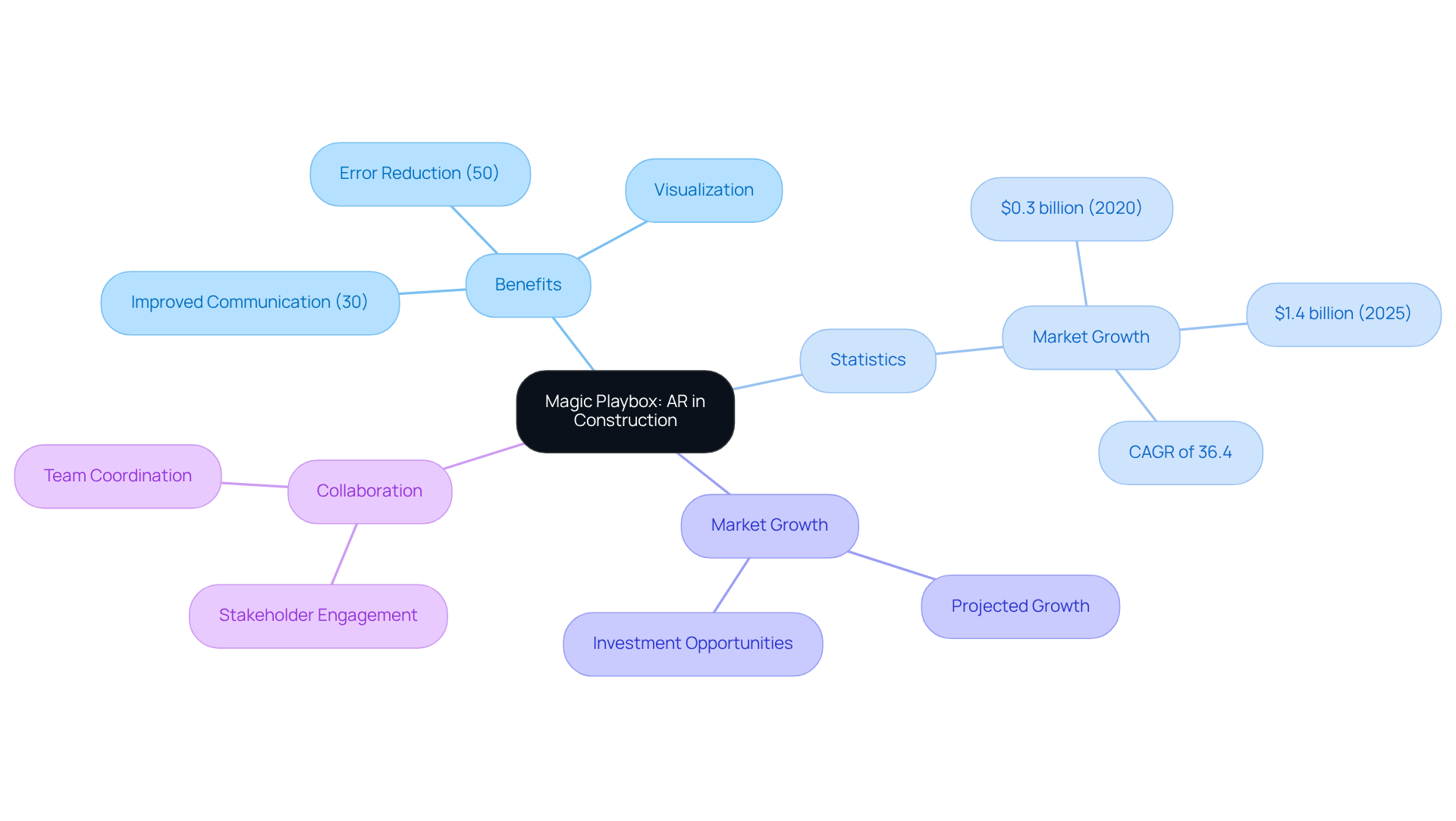
Enhanced Design Visualization: Bringing Projects to Life
The use of augmented reality in building construction empowers architects and engineers to overlay digital models onto physical job sites, thereby offering a vivid representation of the completed structure. This advanced visualization technique, which utilizes augmented reality in building construction, not only enhances clients' and stakeholders' understanding of design intent but also facilitates more effective feedback and necessary adjustments before construction begins.
By immersing users in a 3D environment, augmented reality in building construction transforms traditional blueprints into interactive experiences that can be navigated from multiple perspectives. In fact, research indicates that over 30% of architects are now utilizing augmented reality in building construction for presentations, underscoring its growing importance in the industry.
A notable case study highlights how architects leveraged augmented reality in building construction to gather design feedback, significantly improving collaboration and ensuring alignment with client expectations.
As augmented reality in building construction progresses into 2025, innovations such as AI-driven AR glasses providing real-time suggestions are set to revolutionize design and implementation in architecture and engineering. However, challenges, including high initial costs and the necessity for effective training, persist as barriers to widespread adoption.
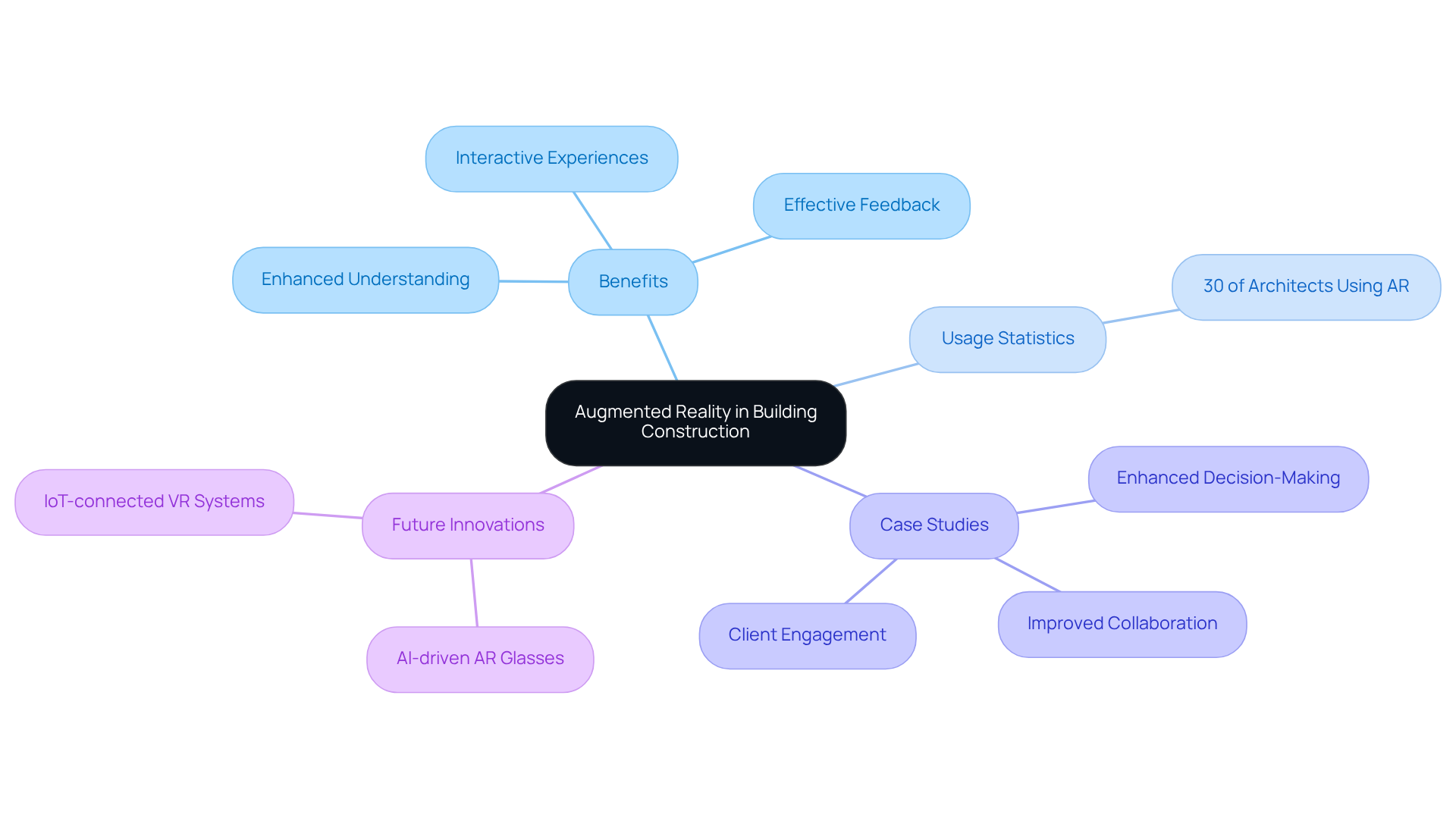
Improved On-Site Communication: Streamlining Project Management
Tools that utilize augmented reality in building construction significantly enhance on-site communication by facilitating real-time interactions between workers and off-site experts. This prompt feedback loop enables teams to visualize data and updates directly at the building site, allowing them to address issues as they emerge.
For instance, the JobWalk app empowers users to explore building sites virtually, capturing progress images and including notes, which streamlines remote inspections and quality assurance. Research indicates that this practical application saves time and resources while maintaining high-quality standards. Such capabilities lessen the necessity for extensive meetings and diminish miscommunication, fostering a cooperative atmosphere where all team members are informed and actively involved in the progress.
Moreover, platforms that utilize augmented reality in building construction, like Microsoft’s HoloLens, allow building professionals to share visuals and discuss design issues remotely, enhancing decision-making efficiency and reducing misunderstandings. The integration of augmented reality in building construction with Building Information Modeling (BIM) significantly enhances coordination and data exchange, resulting in superior outcomes.
However, it is crucial to recognize that incorporating AR into building workflows can face challenges, including resistance from stakeholders unfamiliar with the technology. By addressing these challenges and integrating augmented reality in building construction into project management workflows, building teams can enhance overall efficiency, leading to improved project outcomes and reduced costs.

Safety Training: Utilizing AR for Effective Learning
Augmented reality (AR) is poised to revolutionize safety training, offering immersive simulations that empower workers to practice safety protocols in a risk-free environment. These simulations enable employees to visualize potential hazards and rehearse their responses, providing hands-on experience devoid of the dangers associated with traditional training methods.
Research indicates that immersive learning significantly enhances retention rates of safety procedures; notably, 65% of individuals are visual learners, making visual learning particularly effective. This innovative approach not only boosts knowledge retention but also equips workers to adeptly handle emergency situations they may encounter on-site.
For example, AR can simulate diverse building scenarios, such as crane operations and scaffolding setups, allowing trainees to engage with realistic hazards and practice their responses, ultimately fostering a safer work environment.
The integration of augmented reality in building construction into safety training is increasingly recognized as a strategic enhancement, amplifying workforce capability and demonstrating a commitment to health and safety in the building sector.
As noted by Gravity Jack, "Through the use of AR, workers are not just trained; they’re immersed in situations that closely mimic the unpredictability of actual worksites.
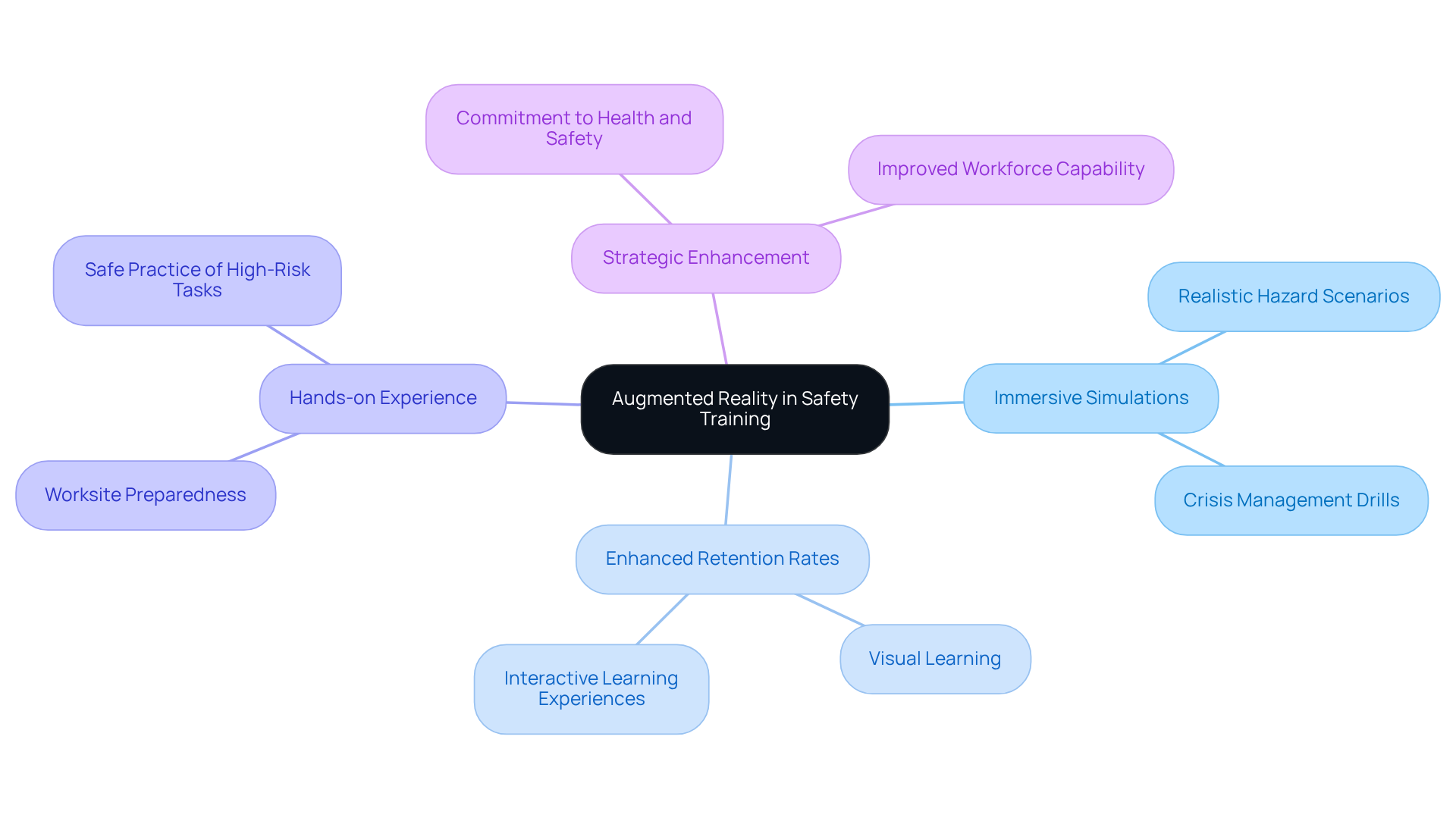
Real-Time Project Visualization: Enhancing Construction Efficiency
Augmented reality in building construction empowers teams to visualize progress in real-time by overlaying digital information onto physical locations. This capability facilitates the immediate identification of discrepancies between planned and actual work, allowing for swift adjustments that minimize costly rework.
For example, the use of augmented reality in building construction alongside Building Information Modeling (BIM) can enhance coordination by up to 50% between operations and design teams, significantly streamlining workflows. As Emily Newton asserts, "AR + BIM can enhance productivity by enabling teams to identify design discrepancies early, avoiding rework and conserving considerable time for the project."
Furthermore, the use of augmented reality in building construction has proven effective in reducing delays in projects and boosting overall productivity. Research indicates that teams utilizing augmented reality in building construction can save significant time during the planning phase by identifying design errors early.
By providing a clear perspective on project status, AR not only enhances operational efficiency but also ensures that tasks remain on track, ultimately resulting in higher quality outcomes and reduced costs.
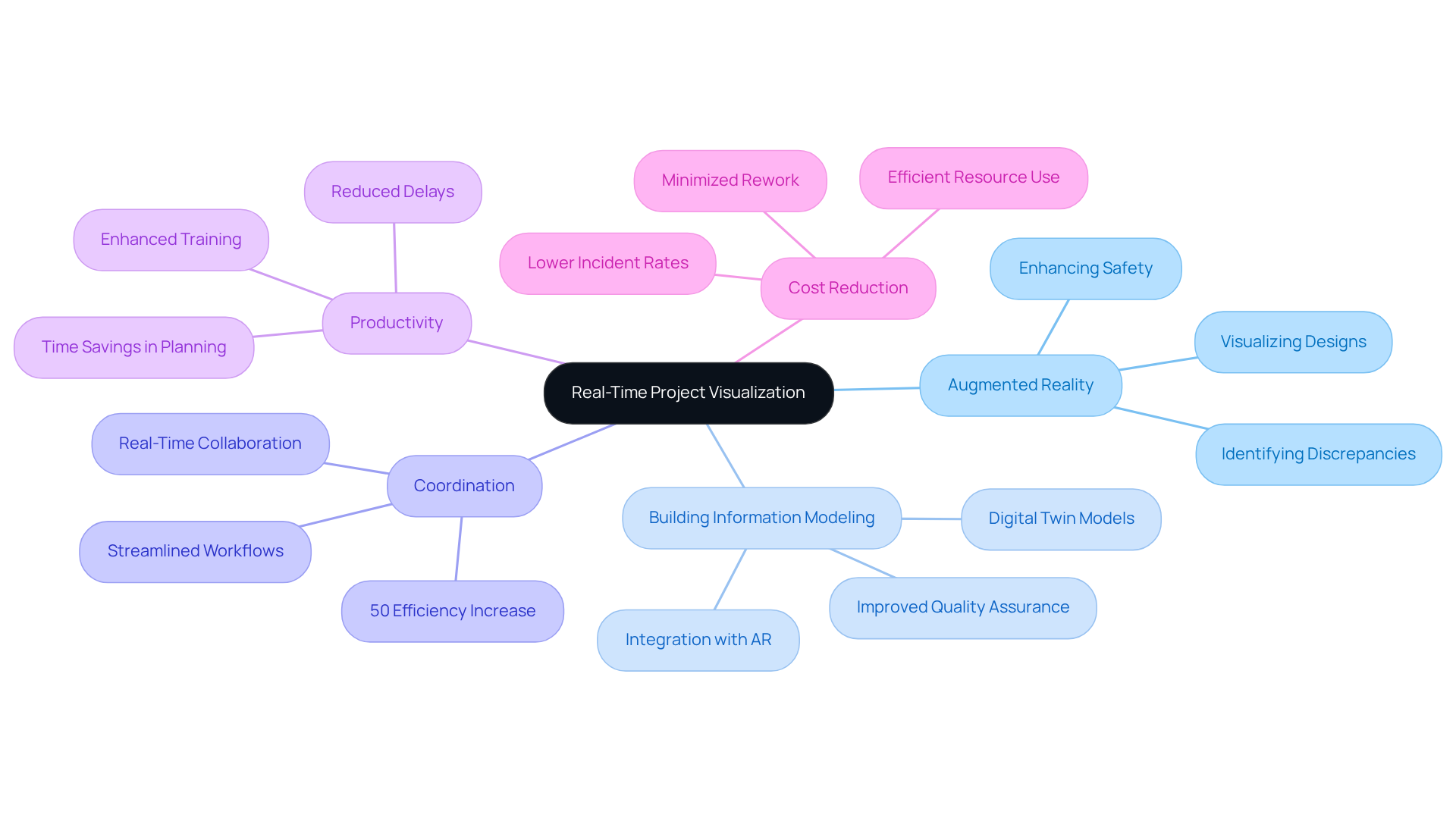
Maintenance and Repair: Leveraging AR for Better Outcomes
The use of augmented reality in building construction is revolutionizing maintenance operations by overlaying digital instructions and schematics directly onto physical equipment. This innovative guidance empowers technicians to visualize internal components with clarity and adhere to step-by-step repair procedures. As a result, the time required for maintenance tasks is significantly reduced.
Research indicates that by enhancing both accuracy and efficiency, AR ensures repairs are completed correctly on the first attempt, thereby minimizing downtime and operational disruptions.
Embrace the future of maintenance with augmented reality in building construction solutions that not only streamline processes but also enhance operational performance.
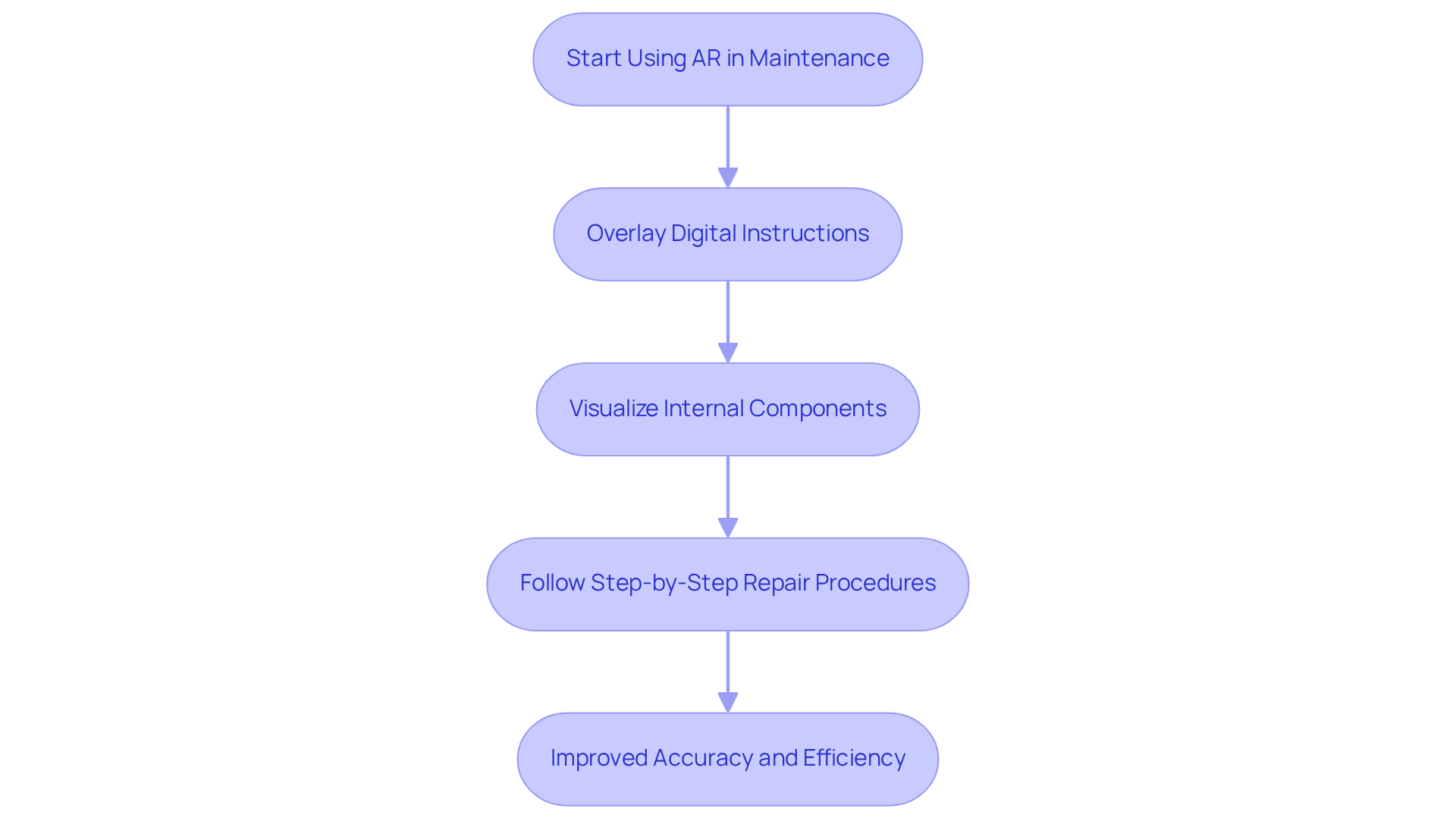
Marketing and Sales: Engaging Clients with Interactive Presentations
Augmented reality in building construction is transforming conventional marketing presentations by allowing prospective clients to interact with 3D representations of building projects. This immersive experience empowers clients to visualize the final product within their own environments, fostering a deeper emotional connection to the project. By showcasing designs in such an engaging manner, building companies can effectively distinguish themselves in a competitive market.
Research indicates that AR-enhanced presentations can significantly boost client conversion rates, with some firms reporting increases of up to 80% in sales after integrating AR into their marketing strategies. Notable examples of augmented reality in building construction include the use of AR applications for virtual site inspections and interactive design reviews, which not only streamline the decision-making process but also enhance client satisfaction.
By leveraging these innovative AR solutions, building firms can create compelling narratives that resonate with clients, ultimately driving engagement and loyalty.
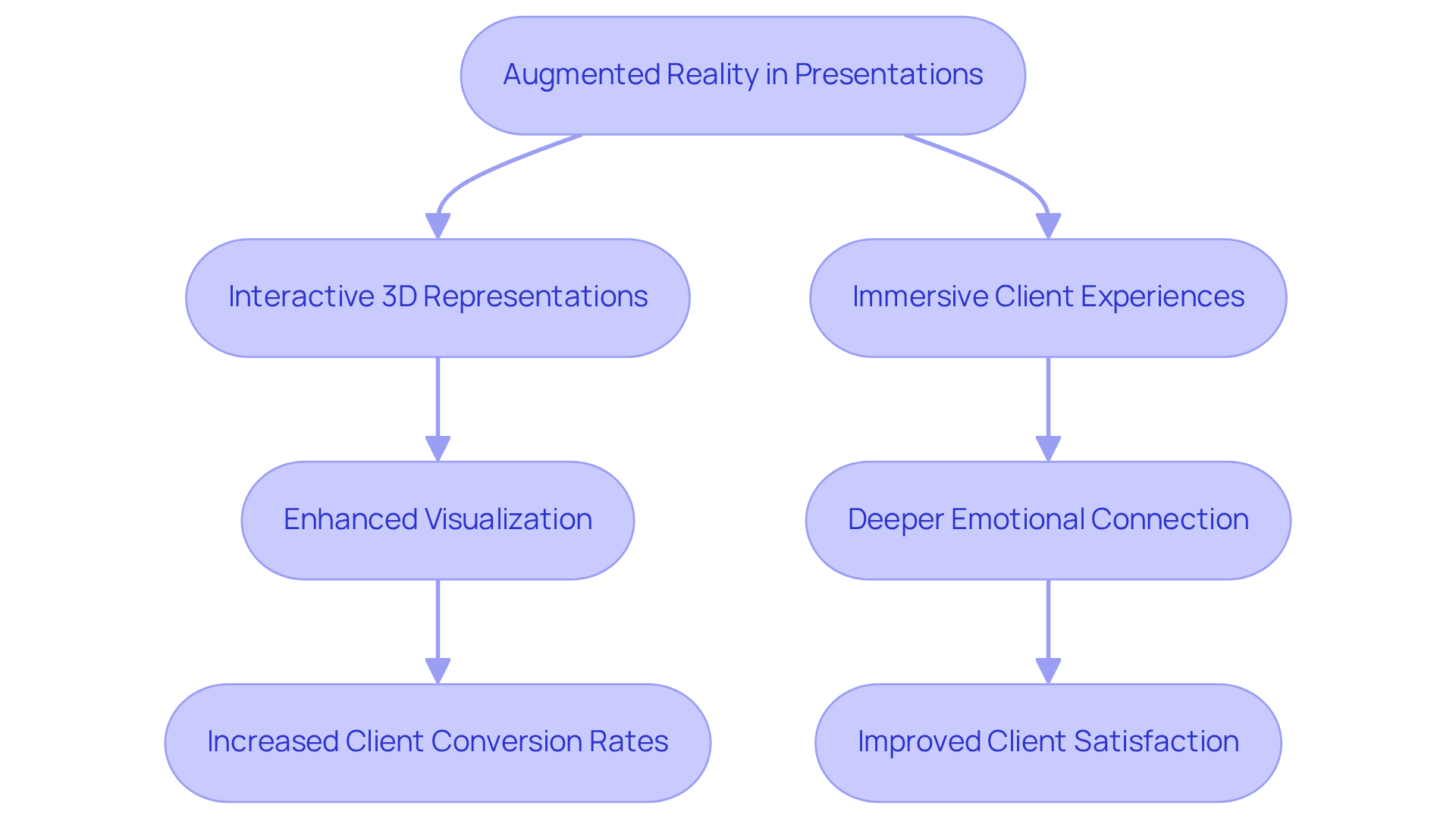
Error Prevention: Visualizing Complex Structures with AR
Augmented reality in building construction enables construction groups to visualize intricate structures and systems prior to installation. By superimposing digital models onto the physical site, teams can proactively identify potential conflicts and design discrepancies early in the process. This method significantly reduces the risk of costly rework, with research indicating that AR can enhance quality and client satisfaction by streamlining workflows and improving accuracy.
For instance, AR-assisted diagnostics enable technicians to visualize hidden elements, such as wiring and plumbing, facilitating faster and more precise maintenance operations. Moreover, the integration of augmented reality in building construction workflows has been proven to decrease project delays and budget overruns, establishing augmented reality in building construction as an essential tool for modern construction practices.
As one engineer remarked, utilizing AR to visualize structures not only aids in a deeper understanding of design but also cultivates a collaborative environment where potential issues can be addressed before they escalate. However, it is crucial to consider challenges in implementing AR technology, including resistance to new methods and the learning curve for workers, to fully capitalize on its benefits.
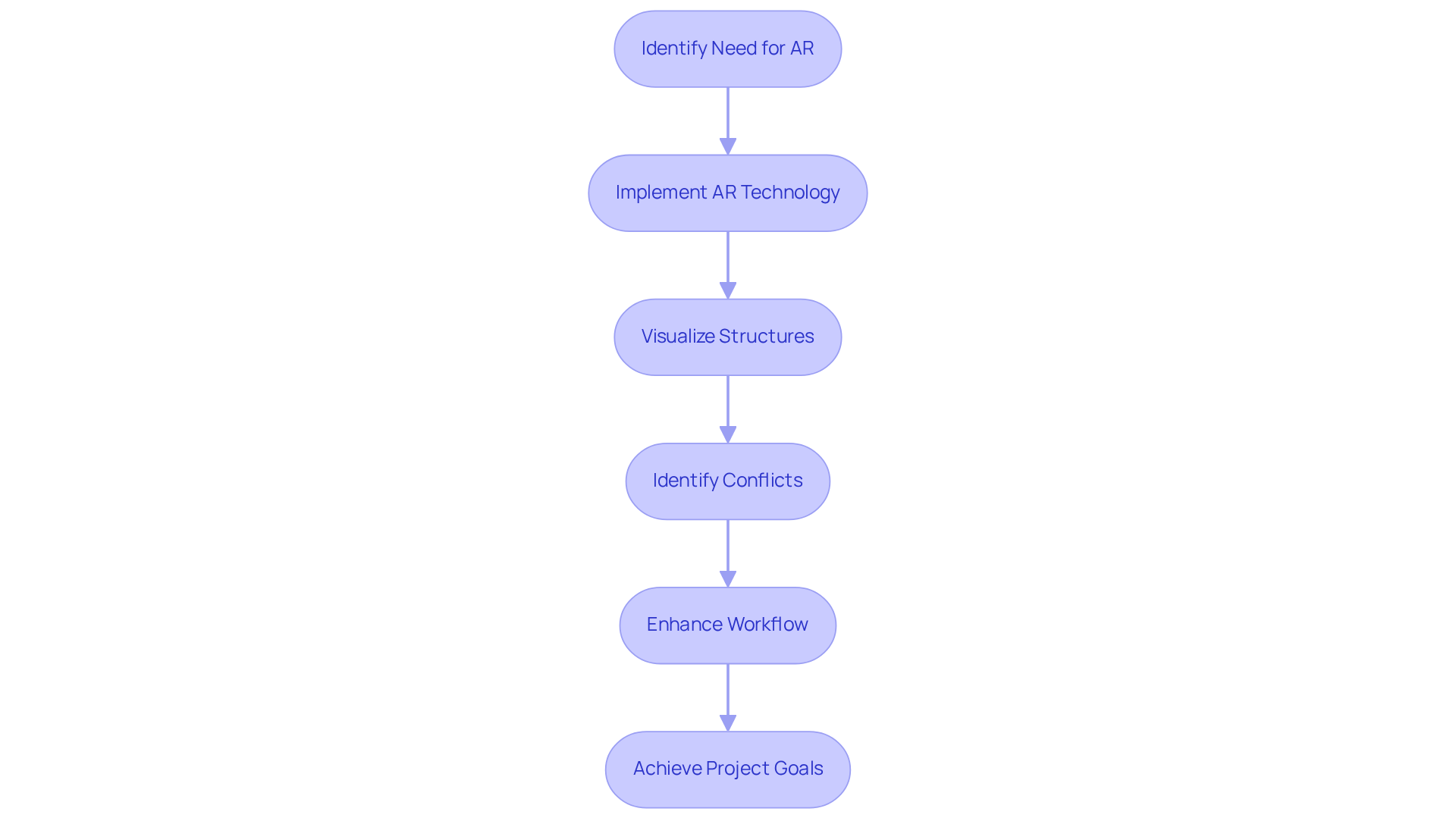
Cost Reduction: Optimizing Workflows with AR Technology
Incorporating augmented reality (AR) into building workflows significantly reduces costs by streamlining processes and minimizing errors. Research indicates that by delivering real-time data and immersive visualizations, AR empowers teams to make informed decisions swiftly, helping to mitigate delays and enhance resource allocation. Notably, almost half (45%) of AR applications in civil infrastructure concentrate on on-site building, showcasing its efficiency in enhancing workflows.
Furthermore, the capacity to envision tasks before building aids in improved budgeting and planning, ultimately resulting in more profitable outcomes. For instance, AR has been demonstrated to decrease rework to under 1% on specific endeavors, leading to substantial cost reductions and enhanced timelines.
Additionally, AR enhances safety on job sites; for example, Mott MacDonald Bentley (MMB) utilized AR to improve safety during excavation work, significantly reducing accidents. This strategic adoption of AR not only improves operational efficiency but also nurtures better client relations and satisfaction, establishing it as an invaluable tool in contemporary management.
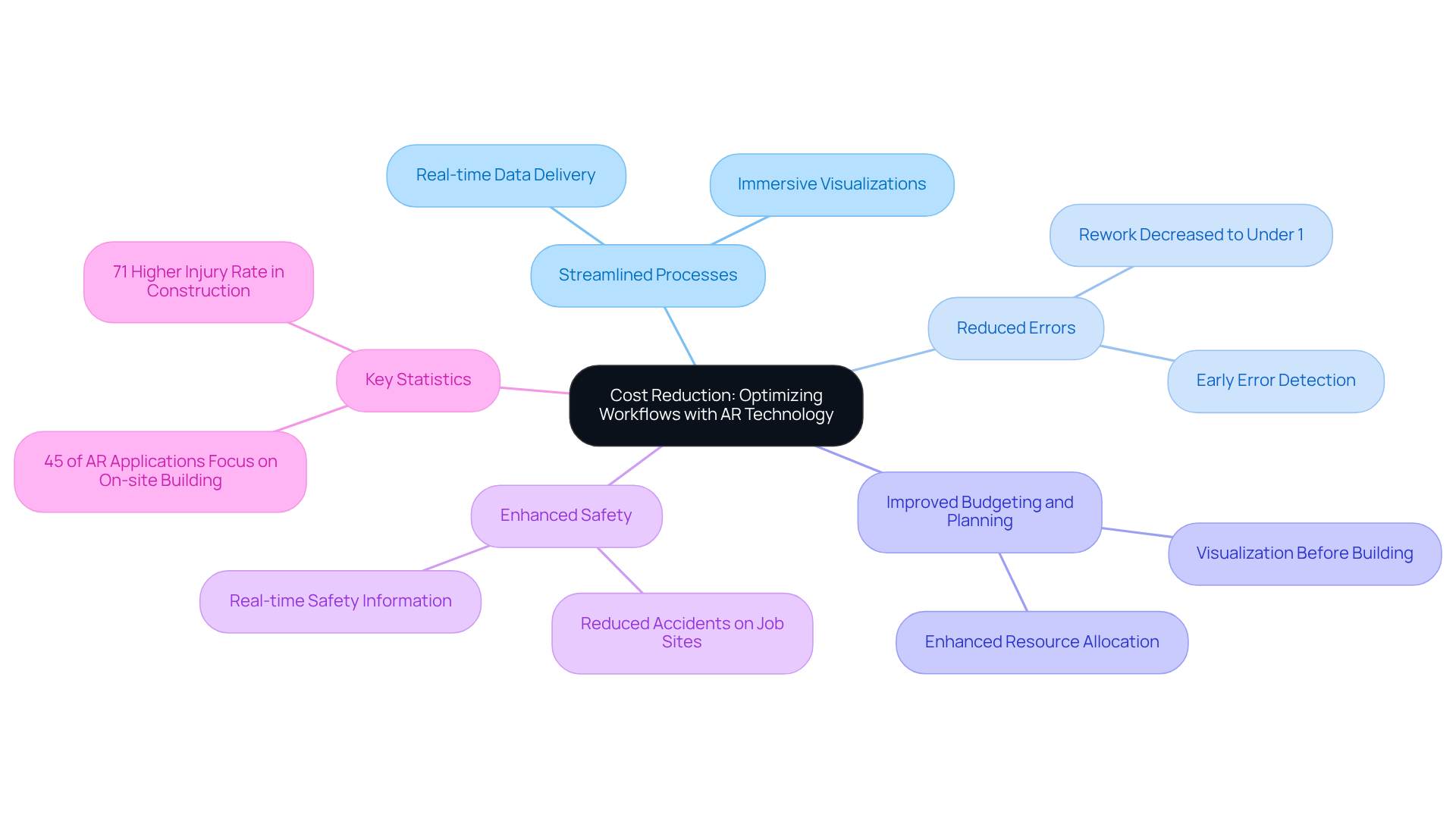
The Future of Construction: Embracing AR Innovations
The advancement of augmented reality in building construction technology is poised to revolutionize the sector by offering innovative solutions that enhance management, design, and client interaction. By integrating AR with artificial intelligence (AI) and the Internet of Things (IoT), construction firms can achieve smarter processes and improved outcomes. For example, augmented reality in building construction tools can overlay digital information onto physical environments, allowing teams to visualize complex designs in real-time, which significantly minimizes errors and rework. A construction management firm reported saving over three weeks of expected rework by utilizing augmented reality in building construction to identify issues early in the project lifecycle. Furthermore, the synergy between building information modeling (BIM) and augmented reality in building construction can boost productivity by preventing rework and saving substantial time.
Moreover, the integration of AR with AI-driven predictive analytics allows firms to scrutinize historical project data, pinpointing potential risks and optimizing resource allocation. This combination not only enhances operational efficiency but also promotes better collaboration among teams, as stakeholders can access real-time data and insights from diverse locations. As Nancy Bhargava, an IT consulting expert, remarks, 'Innovations in augmented reality in building construction and VR are transforming the building industry,' underscoring their role in enhancing safety and efficiency. She further notes that 'the building sector is expanding rapidly in recent years,' emphasizing the imperative for companies to adopt these innovations to maintain a competitive edge.
The adoption of AR, AI, and IoT technologies is no longer optional; it is essential for construction companies striving to excel in a swiftly evolving digital landscape. Additionally, the anticipated surge in digital innovations like BIM and digital twins will further augment management capabilities. However, it is vital to recognize the potential risks and challenges that accompany the implementation of these technologies, including the necessity for robust data security measures. By embracing these innovations, companies can enhance client engagement, streamline workflows, and ultimately deliver superior-quality projects.
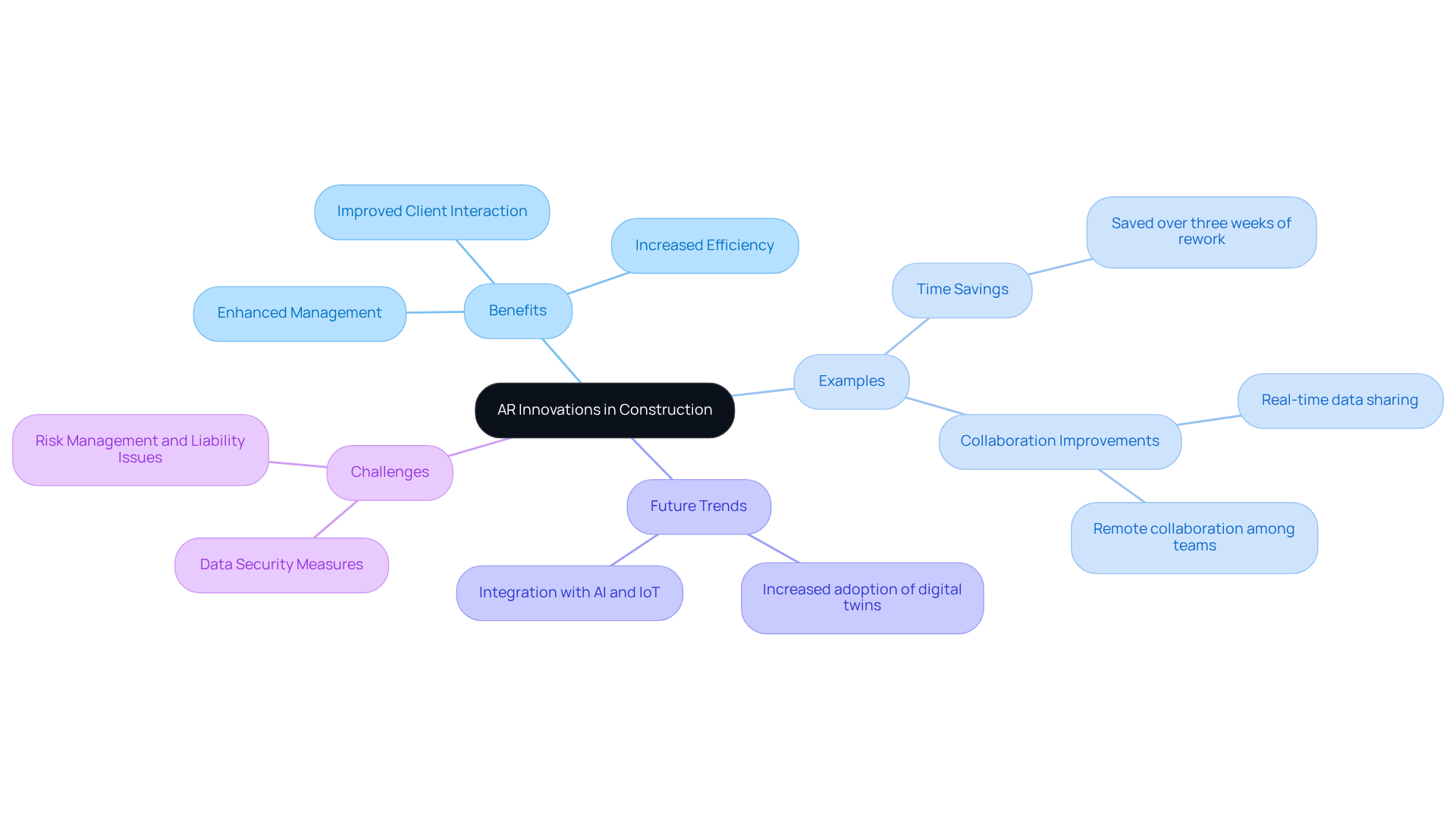
Conclusion
Augmented reality (AR) is revolutionizing the building construction sector by significantly enhancing visualization, communication, and efficiency throughout the project lifecycle. By integrating AR technology, construction teams can craft immersive experiences that not only elevate stakeholder engagement but also streamline processes and minimize errors. The adoption of AR marks a substantial advancement, enabling real-time adjustments and proactive problem-solving, which ultimately leads to superior project outcomes.
Key insights from the article underscore the multifaceted benefits of AR in construction, including:
- Enhanced design visualization
- Improved on-site communication
- Effective safety training
- The ability to visualize intricate structures
Research indicates that AR can reduce errors by up to 50% and enhance communication among teams by as much as 30%. Moreover, the integration of AR with other technologies, such as Building Information Modeling (BIM) and artificial intelligence (AI), positions construction firms to achieve greater operational efficiency and project success.
Embracing augmented reality is not merely a trend; it is a strategic necessity for construction companies striving to excel in a competitive landscape. As the industry continues to evolve, the potential for AR to optimize workflows, enhance client interactions, and improve safety training is expanding. By adopting these innovative solutions, construction firms can streamline their operations and cultivate a culture of collaboration and continuous improvement, ensuring they remain at the forefront of industry advancements.
Frequently Asked Questions
What is Magic Playbox and its role in construction?
Magic Playbox is a studio that integrates augmented reality (AR) in building construction, providing immersive solutions that enhance visualization and stakeholder engagement, empowering building teams to visualize projects in real-time.
How does augmented reality improve construction processes?
Augmented reality can reduce errors by up to 50% and improve communication among teams by as much as 30%, enhancing decision-making and fostering collaboration throughout all phases of development.
What is the projected growth of the AR development market?
The AR development market is projected to grow from $0.3 billion in 2020 to $1.4 billion by 2025, reflecting a compound annual growth rate of 36.4%.
How does augmented reality enhance design visualization?
Augmented reality allows architects and engineers to overlay digital models onto physical job sites, providing a vivid representation of completed structures and facilitating effective feedback and adjustments before construction begins.
What percentage of architects are utilizing augmented reality for presentations?
Over 30% of architects are now utilizing augmented reality in building construction for presentations.
What are some challenges to the widespread adoption of augmented reality in construction?
Challenges include high initial costs and the necessity for effective training to familiarize stakeholders with the technology.
How does augmented reality enhance on-site communication?
AR tools facilitate real-time interactions between workers and off-site experts, allowing teams to visualize data and updates directly at the building site and address issues as they emerge.
What is the JobWalk app and how does it function?
The JobWalk app allows users to explore building sites virtually, capturing progress images and including notes, which streamlines remote inspections and quality assurance while saving time and resources.
How does AR integrate with Building Information Modeling (BIM)?
The integration of AR with BIM enhances coordination and data exchange, resulting in superior project outcomes and improved efficiency.
What are some barriers to incorporating AR into building workflows?
Barriers include resistance from stakeholders who may be unfamiliar with the technology, which can hinder its integration into project management workflows.




